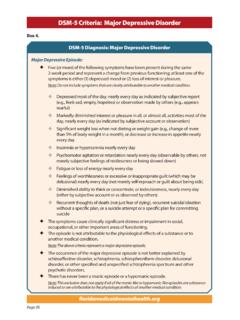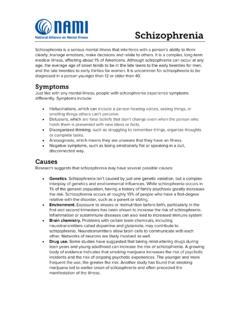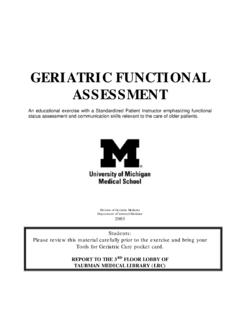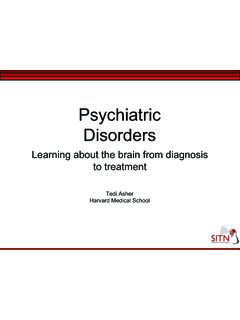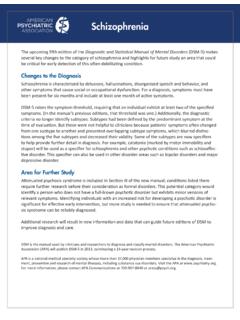Transcription of DSM-5 Criteria: Schizophrenia
1 Page 40 Criteria: Schizophrenia FTwo (or more) of the following, each present for a significant portion of time during a 1-month period (or less if successfully treated). At least one of these must be delusions, hallucinations or disorganized speech: Delusions Hallucinations disorganized speech ( , frequent derailment or incoherence) Grossly disorganized or catatonic behavior Negative symptoms ( , diminished emotional expression or avolition) FContinuous signs of the disturbance persist for at least 6 months. This 6-month period must include at least 1 month of symptoms (or less if successfully treated) that meet the above criteria ( , active phase symptoms) and may include periods of prodromal or residual symptoms. During these prodromal or residual periods, the signs of the disturbance may be manifested only be negative symptoms or by two or more symptoms listed above present in an attenuated form. FFor a significant portion of time since the onset of the disturbance, level of functioning in one or more major areas, such as work, interpersonal relations, or self-care is markedly below the level achieved prior to the onset (or when the onset is in childhood or adolescence, there is a failure to achieve expected level of interpersonal, academic, or occupational functioning).
2 FSchizoaffective disorder and depressive or bipolar disorder with psychotic features have been ruled out. FThe disturbance is not attributable to the physiological effects of a substance ( , a drug of abuse, a medication) or another medical condition. FIf there is a history of autism spectrum disorder or a communication disorder of childhood onset, the additional diagnosis of Schizophrenia is made only if prominent delusions or hallucinations, in addition to the other required symptoms of Schizophrenia , are also present for at least 1 month (or less if successfully treated).Box 5. DSM-5 Diagnosis: SchizophreniaPa g e 41 of SchizophreniaNote: Treatment recommendations are based on levels of evidence and expert opinion. For a description of the criteria for each level, see page 4. Conduct comprehensive assessment and use measurement-based care. Refer to Principles of Practice on pages 6 importantly, assess social support system (housing, family, other caregivers) and evaluate threats to continuity of care (access to medication, adherence, etc.)
3 Strongly recommend psychiatric consultation prior to initiation of therapy + psychotherapeutic medication using a multi-disciplinary approach if treated by a 1 Initial Treatment: FMonotherapy with an antipsychotic (SGA) other than clozapine* either oral, or oral antipsychotic followed by the same SGA-LAI (if tolerable and sufficiently efficacious) FIf initial trial of antipsychotic monotherapy unsuccessful, try monotherapy with another SGA antipsychotic (either oral or LAI) with low metabolic adverse effects.*Note: Balance efficacy, side-effects, individual vulnerabilities and preferences. Select a medication with lower metabolic risk, lower risk of extrapyramidal symptoms (EPS), sedation, and sexual side-effects. For more detail on LAIs, refer to page 2A If non-adherent or refractory to Level 1: FLong-acting injectable antipsychotic medication (LAI)Level 2B If Level 1 is ineffective in at least two antipsychotic trials: FClozapineLevel 3 If Levels 1 and 2 are ineffective and/or not well tolerated: FDiagnostic review and/or consultation FClozapine if not tried earlier FAntipsychotic, including clozapine + electroconvulsive therapy (ECT) FAugmentation of clozapine with aripiprazole, lamotrigine, topiramate or if partial or incomplete response to clozapineLevel 4 If Levels 1, 2, and 3 are ineffective and/or not well tolerated: FTwo antipsychotics, ideally with different pharmacological mechanisms* and side-effect profiles (evidence is weak) FFirst generation antipsychotic use*Full antagonist with partial agonist.
4 Loose binding with tight bindingPage 42 EquivalentsaAcute TherapyMaintenance TherapybFirst Generation Antipsychotics (FGAs)Chlorpromazine100300 1,000 mg/day300 800 mg/dayFluphenazine HCl25 20 mg/day5 15 m g /dayHaloperidol25 20 mg/day6 12 m g /d ayLoxapine1030 100 mg/day30 60 mg/dayMolindone1030 100 mg/day30 60 mg/dayPerphenazine816 80 mg/day16 64 mg/dayThiothixene515 50 mg/day15 30 mg/dayTrifluoperazine515 50 mg/day15 30 mg/daySecond Generation Antipsychotics (SGAs)AripiprazoleN/A10 -30 mg/day10 30 mg/dayAsenapineN/A10 20 mg/day10 20 mg/dayBrexpiprazoleN/A2 4 mg/day2 4 mg/dayCariprazineN/A1. 5 6 mg/day3 6 mg/dayClozapineN/A150 800 mg/day150 800 mg/dayIloperidoneN/A12 24 mg/day12 24 mg/dayLurasidoneN/A40 160 mg/day40 160 mg/dayOlanzapineN/A10 30 mg/day10 20 mg/dayPaliperidoneN/A3 12 m g /d ay3 12 m g /d ayQuetiapineN/A300 800 mg/day300 800 mg/dayRisperidoneN/A2 8 mg/day2 8 mg/dayZiprasidoneN/A80 240 mg/day80 160 mg/dayNotes: Recommendations may be below FDA maximum approved doses but are based on current evidence and expert lower doses for first episode due to better response and higher side effects to medications in pharmaceutically na ve patients.
5 Use atypical antipsychotics and avoid haloperidol completely due to well-documented neuronal cell death caused by haloperidol (and also fluphenazine and perphenazine). Thioridazine is not recommended due to concerns about ventricular arrhythmias (Torsades de Pointes).aApproximate dose equivalent to 100 mg of chlorpromazine (relative potency); it may not be the same at lower versus higher doses. Chlorpromazine equivalent doses are not relevant to the second generation antipsychotics and therefore are not provided for these interactions (DDIs) can impact dosing. Maintenance dose should generally be no less than half of the initial clinically effective dose, as that can result in reduced effectiveness of relapse 4. Recommended Medications for the Treatment of Schizophrenia : Oral AntipsychoticsPage 43 Note: Treatment recommendations are based on levels of evidence and expert opinion. For a description of the criteria for each level, see page 4. Conduct a comprehensive assessment and use measurement-based care as found in the Principles of Practice on pages 6 social determinants (housing, family, other caregivers) and evaluate threats to continuity of care (access to medication, adherence, etc.)
6 Strongly recommend psychiatric consultation prior to initiation of therapy + psychotherapeutic medication using a multi-disciplinary approach if treated by a 1 Initial Treatment: FAfter stabilization or obtaining sufficient evidence for efficacy and tolerability, offer any of the following long-acting injectable antipsychotics (LAI). Base the selection on past efficacy and tolerability patterns to specific oral or LAI, expected tolerability advantages*, desired injection intervals, and procedural (oral overlap needed- yes versus no)/logistic/access/cost considerations: Aripiprazole monohydrate Aripiprazole lauroxil Paliperidone palmitate Risperidone microspheres Risperidone extended release subcutaneous injectable. FIf initial, adequate trial (minimum 3 to 4 months) of LAI is unsuccessful, try monotherapy with another LAI from the above group or address potential reasons for efficacy difficulty on the LAI. Refer to Figure 1: Management of Breakthrough Psychosis with LAI for options to consider if psychotic symptoms persist despite adequate medication trial.
7 *Note: Balance efficacy, side-effects, individual vulnerabilities and preferences. Select medication with lower propensity for metabolic and extrapyramidal 2 If Level 1 is ineffective and/or not well tolerated: FConsider LAI with greater adverse effect risk [olanzapine: post-injection delirium/sedation syndrome (PDSS); FGA-LAIs: EPS, TD] Olanzapine pamoate Fluphenazine decanoate Haloperidol decanoateLevel 3 If Levels 1 and 2 are ineffective and/or not well tolerated: FDiagnostic review and/or consultation FConsider switch to an oral antipsychotic not available as an LAI (if adherence can be assured) FClozapine if not tried earlier FLAI + electroconvulsive therapy (ECT) or oral antipsychotic FClozapine + ECTT reatment of Schizophrenia with Long-Acting InjectableAntipsychotic Medications (LAIs)Page 44 Figure 1. Management of Breakthrough Psychosis with Long-Acting Injectable Antipsychotics (LAIs)From Correll CU, et al. CNS Spectrums 2018; 27: 1 psychotic symptomsOptions to consider Rule out / address medical illness or substance use as a contributing factor Address stressors and optimize non-pharmacological treatments Treat comorbidities Ensure proper LAI administration Address missed LAI doses appropriately Increase LAI dose Shorten LAI injection interval (increase LAI AP dose) *Options to consider Rule out or address medical illness or substance use as a contributing factor Address stressors and optimize non-pharmacological treatments Treat concomitant medical and psychiatric comorbidities Ensure proper LAI administration Address missed LAI doses Increase LAI dose Shorten LAI injection interval ( LAI dose)
8 * Re-implement oral AP Switch LAI Options to consider Rule out or address medical illness or substance use as a contributing factor Address stressors and optimize non-pharmacological treatments Treat concomitant medical and psychiatric comorbidities Ensure proper LAI administration Address missed LAI doses Increase LAI dose Shorten LAI injection interval ( LAI AP dose)* Change the oral AP (if given adjunctively) Switch LAIS ymptomspersistSymptomspersistSymptoms persistor worsenSymptoms recurNot improvedImprovedSymptoms stabilize or abateSlowly discontinue oral AP ( 2 weeks after start of oral AP coverage)Evaluate symptoms initially after 1 2 weeks and then as clinically appropriateEvaluate symptoms initially after 1 2 weeks and then as clinically appropriateEvaluate symptoms initially after 1 2 weeks and then as clinically appropriateEvaluate symptoms initially after 1 2 weeks and then as clinically appropriateIncrease oral AP to optimum effective dose *Off-label strategy; based on expert opinion.
9 Caution should be exercised with this strategy, because data on the safety of concomitant use of LAI and oral APs are limited, especially over extended periods of with low dose of corresponding oral AP formulation for fast symptom control Page 45 MedicationDose IntervalDosage Strengths/FormsStarting DoseMaintenance DoseOral SupplementationTime to PeakSteady StateFirst-Generation Long-Acting Injectable Antipsychotics*Fluphenazine decanoateVaries25 and 100 mg/mL ampoules/vials/syringesVaries, mgVaries, to 100 mgNo2 to 4 days2 to 3 monthsHaloperidol decanoate4 weeks50 and 100 mg/mL ampoulesVaries, 50 mgVaries, 300 mgNo6 to 7 days2 to 3 monthsSecond-Generation Long-Acting Injectable Antipsychotics*Aripiprazole monohydrate(Abilify Maintena )Monthly300, 400 mg vial kits and dual-chamber syringe400 mg400 mg(300 to 400 mg)2 weeks5 to 7 days400 mg: 4 to 8 months300 mg: 3 to 4 months(Aripiprazole lauroxil (Aristada )Monthly for 441 mg dose; monthly to every 6 weeks for 882 mg dose; bimonthly for 1,064 mg dose441; 662; 882; 1,064 mg prefilled syringesVaries 441 mg to 1,064 mg**Varies, 441 to 882 mg3 weeks if Aristada Initio is not administered at the beginning of treatment.)
10 If initiating treatment with Aristada Initio , 1 day oral supplementation with aripiprazole 30 mg tablet is days4 to 6 monthsTable 5. Recommended Medications for the Treatment of Schizophrenia :Long-Acting Injectable AntipsychoticsPage 46 MedicationDose IntervalDosage Strengths/FormsStarting DoseMaintenance DoseOral SupplementationTime to PeakSteady StateAripiprazole lauroxil (Aristada Initio )Once at the beginning to initiate aripiprazole lauroxil (Aristada ) treatment675 mg 675 mgNot applicable (N/A)1 day (aripiprazole 30 mg tablet) therapeutic levels in 4 days27 daysWith single IM injection of Aristada initio and 30 mg oral aripiprazole at time of first Aristada dose, aripiprazole concentration reaches therapeutic levels within 4 daysOlanzapine pamoate (Zyprexa Relprevv )2 to 4 weeks210, 300, 405 mg vial kitsVaries, up to 300 mg every 2 weeksVaries, up to 300 mg every 2 weeksNo4 days3 monthsPaliperidone palmitate (Invega Sustenna )Monthly39, 78, 117, 156, 234 mg prefilled syringes234 mg (day 1) + 156 mg (day 8)117 m g (39 to 234 mg)No13 day s7 to 11 monthsPaliperidone palmitate (Invega Trinza )
